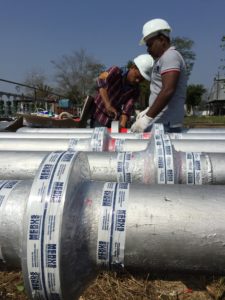Midstream Oil and Gas - trunklines and separation plants.
Midstream starts, where upstream ends.
The midstream is, where the crude oil is separated in mainly Oil, Gas and Water. Where the crude oil or the natural gas is transported in trunk lines or pipe lines. Over long distances to the industry doing the finaly processing of the hydrocarbon. The refineries, petrochemical plants or to the shipping facilites for export.
Separation Plants - FPSO - Storage
Landbased separation plants are the heart of the midstream sector. Offshore such a plant is called FPSO, meaning Floating Production Storage and Offloading Unit. The processing is the same offshore or onshore.
The oil or the gas is coming either direct from wells in flow lines, or from other storage facilities in bigger trunk lines. The purpose of such midstream plants is processing the incoming crude. To separate and purify all the major ingredients in the crude.
The crude which is coming to a separation plant is a mixtrue of oil, gas and water. As a rule of thumb, as longer an oil field is producing, as more water is in the crude oil.
Trunk lines - pipe lines
 The purified oil and gas is forwarded to down stream operations. The water is called produced water and is either treated in a waste water plant, or is reused in water injection wells to pressurize the reservoir. This is done to ensure continuous processing in midstream, that the oil production continues all the time.
The purified oil and gas is forwarded to down stream operations. The water is called produced water and is either treated in a waste water plant, or is reused in water injection wells to pressurize the reservoir. This is done to ensure continuous processing in midstream, that the oil production continues all the time.
To transport the oil from midstream to downstream often very long distances has to be covered. There are pipelines crossing the Arabian peninsular, connecting the Persian gulf and the Red Sea. Or in Northamerica there is a pipeline connecting the Prudhoe Bay in Alaska with refineries in Chicago, Illinois. But in most cases neither the distances nor the volumes are so large.
Such pipe lines are laid above earth, below earth or offshore below see. The integrity of thes pipeline is very close watched and controlled.
Priority is to avoid, that there is oil leacking and polluting the environment.
What Merus can contribute in midstream processing
Merus can improve a lot of processing steps in midstream.
- there is the corrosion, scaling and fouling in the trunk lines
- the waxing in the trunk lines and so reduce the pigging frequency
- influencing the pour point
- reducing microbiological induced corrosion, caused by SRB for instance
- reducing emulsion, both in the trunk lines and the separation plant
- improving the separation. Make the process faster and having purer water and oil
- reducing demulsifier, deoiler, sludge breaker and a lot more
Continue reading about upstream or downstream
